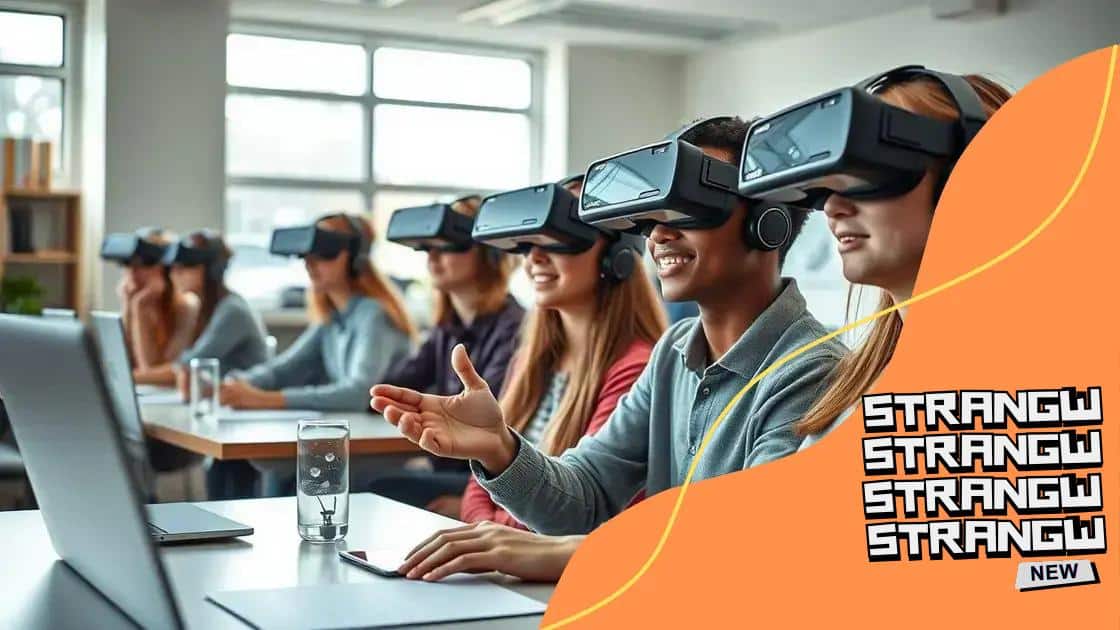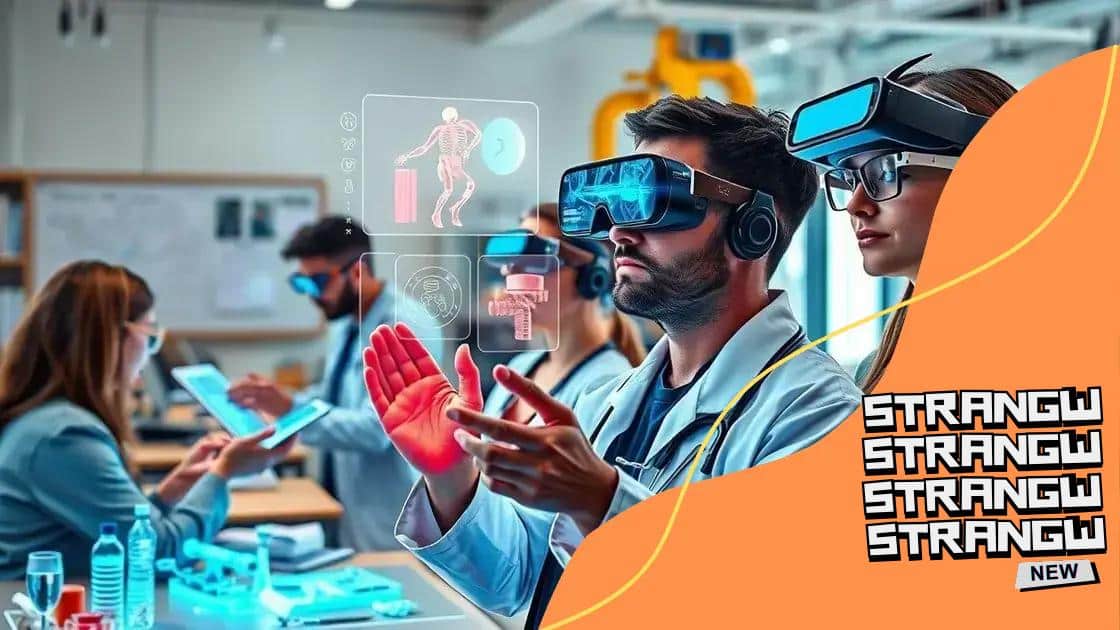How AR is being used for hands-on learning experiences

Augmented reality (AR) is revolutionizing hands-on learning experiences in education by enhancing engagement, providing realistic simulations, and facilitating personalized learning opportunities.
How AR is being used for hands-on learning experiences is transforming education. Imagine students exploring anatomy or history through lifelike simulations right in their classrooms. Curious about how this technology shapes learning?
Understanding augmented reality in education
Understanding augmented reality in education is essential as it reshapes how students learn and engage with content. By overlaying digital information onto the real world, AR creates immersive learning experiences that can enhance student understanding and retention.
What is Augmented Reality?
Augmented reality is a technology that superimposes digital information—images, sounds, and other data—onto the real world. This technology can be accessed through devices like smartphones and tablets, making it widely available for educational purposes.
Benefits of AR in Education
Implementing AR in classrooms offers several benefits:
- Engages students by making learning interactive.
- Enhances understanding of complex concepts.
- Supports diverse learning styles.
- Encourages collaboration among peers.
These advantages can transform a traditional learning environment into a dynamic space where students are excited to participate.
When students use AR, they can visualize concepts such as anatomy or astronomy in ways that books cannot convey. For instance, a student studying the human body can view 3D models of organs, allowing them to understand anatomy better than through textbook illustrations alone.
Real-World Applications of AR
Several educational institutions are successfully incorporating AR into their curricula:
- Forbes High School uses AR to teach historical events through interactive timelines.
- Engineering students at NYU leverage AR for hands-on practice with complex machinery.
- Art classes utilize AR to explore famous paintings and learn techniques visually.
These examples highlight how AR can create personalized and responsive learning experiences, paving the way for innovative education.
As technology continues to develop, the potential for augmented reality in education seems limitless. By continuing to explore this technology, schools can prepare students for a future that increasingly relies on digital integration in various fields.
Benefits of AR for practical skills acquisition
The benefits of augmented reality (AR) for practical skills acquisition are profound and transformative. By providing immersive and engaging learning experiences, AR can significantly enhance the way individuals gain and apply skills in various fields.
Enhanced Engagement and Motivation
AR captures the attention of learners in a way that traditional methods cannot. When students interact with 3D models while learning practical skills, they are more likely to stay engaged.
Realistic Simulation Experiences
One of the standout advantages of AR is the ability to create realistic simulations. For example, medical students can practice surgeries without risking patient safety. Likewise, technical training programs can simulate machinery operations, providing hands-on experience in a controlled environment.
- Increases real-world applications of skills learned.
- Encourages learners to practice without the fear of making mistakes.
- Facilitates immediate feedback for skill improvement.
Furthermore, AR technologies can also assist learners in visualizing complex tasks and processes. This ability to see and manipulate virtual objects enhances understanding, leading to better-than-average retention rates for newly acquired skills.
Support for Diverse Learning Styles
Every learner is different. Some students grasp concepts through visual aids, while others benefit from kinesthetic experiences. AR accommodates various learning styles by offering multiple avenues for engagement. The visual aspects of AR help clarify complex concepts, while the interactive components allow learners to practice and refine their skills actively.
For instance, a student learning about construction can utilize AR to visualize building structures. By seeing the components of a project in three dimensions, the student can better understand how different elements interact with one another.
Collaboration Opportunities
AR not only aids individual learning but also promotes collaboration among peers. Group projects involving AR encourage teamwork. Students can share their experiences and learn from one another as they work toward a common goal.
The integration of AR in education is reshaping the landscape of skill acquisition. As more institutions embrace this technology, the opportunities for practical learning will only continue to expand.
Examples of AR applications in various fields

Examples of AR applications in various fields provide insight into how this technology is revolutionizing different industries. From education to healthcare, augmented reality enhances learning, training, and practical applications.
Education
In schools, AR allows students to explore complex subjects interactively. For instance, when studying biology, students can view 3D models of cells or organs via their devices, bringing textbook diagrams to life.
- Interactive learning modules that simulate real-world scenarios.
- Virtual field trips that allow students to experience different cultures and landscapes without leaving the classroom.
- Enhanced engagement through gamified learning experiences.
This approach keeps students curious and excited about their lessons.
Healthcare
In the healthcare sector, AR is transforming how medical professionals train and perform procedures. Surgeons can use AR to overlay critical information during operations, giving them a clearer view of anatomy.
- AR-assisted surgeries that provide real-time data and guidance.
- Training simulations for medical students, offering hands-on experience in a safe environment.
- Visualizing patient anatomy using 3D modeling for better diagnostics.
This technology not only helps doctors but also improves patient outcomes significantly.
Manufacturing and Maintenance
In manufacturing, AR enhances efficiency by guiding workers through complex assembly processes. Technicians can receive real-time instructions overlaid on equipment, reducing errors and improving accuracy.
When performing maintenance, workers can visualize how to repair machinery step by step, preventing costly mistakes. Additionally, AR can be used to train new employees by providing interactive guides and tutorials, ensuring they are well-prepared for their roles.
Retail
Augmented reality in retail offers customers a unique shopping experience. Many stores now use AR apps to allow customers to visualize products in their own homes before purchasing.
- Virtual fitting rooms that help shoppers try on clothes virtually.
- Home design applications that let users see how furniture will look in their spaces.
- Enhanced product displays that offer more information
These applications help consumers make informed decisions and improve satisfaction.
Across various sectors, the potential for AR applications is vast and continues to grow. As more fields integrate this technology, the possibilities for innovation remain limitless.
Challenges to implementing AR in learning
Implementing augmented reality (AR) in learning comes with several challenges that educators and institutions must navigate. While the benefits of AR are clear, understanding and addressing these obstacles is essential for successful integration.
Cost of Technology
One of the main challenges is the cost associated with AR technology. Schools and educational institutions may face high expenses for AR devices, software, and maintenance. Budget constraints can limit the ability of many schools to adopt AR solutions, especially in underfunded areas.
- Investment in hardware such as tablets or AR glasses.
- Licensing costs for educational AR software.
- Ongoing maintenance and software updates.
These financial barriers can hinder the widespread adoption of AR in classrooms.
Need for Training
Another significant challenge is the need for training educators to effectively use AR tools. Teachers not only need to learn how to operate the technology, but they must also understand how to integrate it into their lesson plans. Without proper training, AR technology may not be used to its full potential.
Training programs are essential for:
- Familiarizing teachers with AR tools and features.
- Developing strategies to effectively incorporate AR into curricula.
- Providing ongoing support as technology evolves.
Without sufficient training, the potential of AR can be lost.
Technical Issues
Technical issues can also pose significant challenges when implementing AR in learning. These problems can range from connectivity issues to software glitches. When technology does not work as intended, it can disrupt the learning experience and impact student engagement.
Common technical concerns include:
- Inadequate internet connectivity in some schools.
- Device compatibility issues that limit access.
- Insufficient technical support to resolve problems quickly.
These technical barriers can make the learning experience less effective.
Content Development
Creating high-quality AR content that is educational and engaging can be challenging. Schools must ensure that the content meets educational standards and is suitable for their specific curriculum. Furthermore, the creation process can be time-consuming and complex, requiring skilled personnel.
To address this challenge, institutions need to invest in:
- Collaboration with AR developers to create tailored content.
- Utilizing existing AR educational resources wherever possible.
- Ensuring content is regularly updated to maintain relevance.
Overall, while AR has great potential to enhance learning, overcoming these challenges is crucial for effective implementation in educational settings.
Future trends of AR in education
The future trends of augmented reality (AR) in education are shaping how we think about learning. As technology continues to evolve, AR is expected to play an even more significant role in classrooms around the world.
Increased Accessibility
In the coming years, we can expect AR to become more accessible. With advancements in smartphone technology, more students will have access to AR applications. Schools may also adopt lower-cost solutions that integrate AR into their existing curriculum.
Personalized Learning Experiences
Another trend is the movement toward personalized learning. AR can help tailor educational experiences to meet individual student needs. By offering customized interactive experiences, AR allows students to learn at their own pace. This can be particularly beneficial for students who need extra support or those who excel and require more challenging material.
Some potential benefits of personalized AR learning include:
- Adaptive content that changes based on student interaction.
- Feedback that helps students understand their progress.
- Engagement strategies designed to maintain interest in the subject.
Integration with Other Technologies
AR will also likely be integrated with other emerging technologies. For instance, combining AR with Artificial Intelligence (AI) can enhance learning environments significantly. AI can analyze student performance and offer real-time suggestions for AR content that suits their learning needs.
This integration can lead to creating smarter classrooms where:
- Students receive tailored resources based on their learning style.
- Teachers can monitor engagement and comprehension dynamically.
- Learning environments adapt based on student actions.
Use in Remote Learning
As remote learning becomes more common, AR can bridge the gap between in-person interactions and virtual ones. Students attending classes online can use AR to simulate a classroom experience, enhancing their connection to the material. This potential can increase participation and motivation in remote settings.
Additionally:
- AR can facilitate virtual tours of historical sites or scientific environments during remote lessons.
- Students can collaborate on projects in virtual spaces, creating a sense of community.
Overall, the future trends indicate that AR in education will continue to expand and evolve. As barriers diminish, the integration of AR finds its way into regular teaching practices, potentially transforming how education is delivered and experienced.
FAQ – Frequently Asked Questions about Augmented Reality in Education
What is augmented reality in education?
Augmented reality in education enhances learning experiences by overlaying digital information on the real world, making concepts more interactive and engaging.
How can AR improve student engagement?
AR captures students’ attention by providing immersive experiences, allowing them to explore subjects in a hands-on way, which keeps them interested and motivated.
What are some challenges in implementing AR in classrooms?
Challenges include cost, the need for teacher training, technical issues, and the development of suitable educational content.
What does the future hold for AR in education?
The future of AR in education includes increased accessibility, personalized learning experiences, integration with other technologies, and applications in remote learning.





